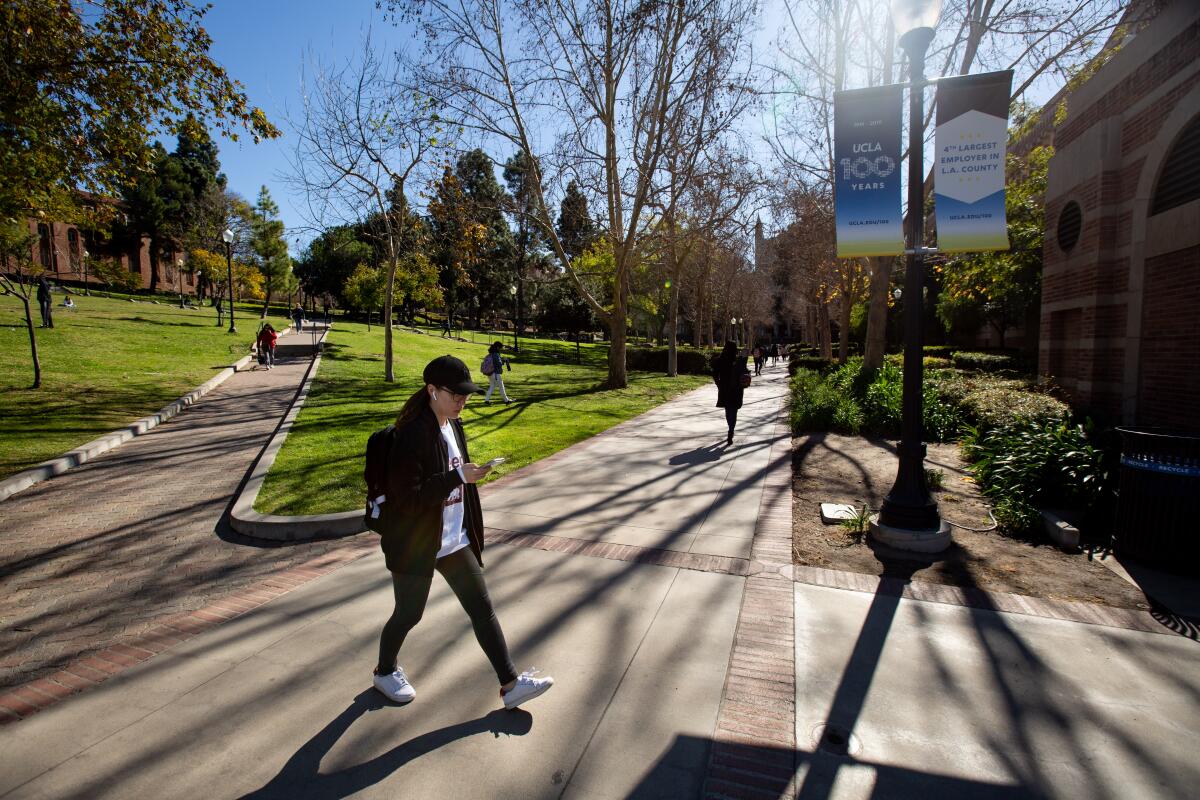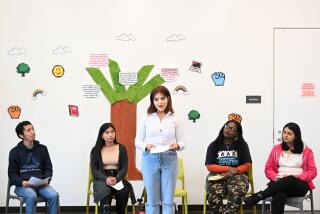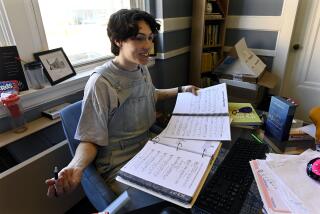High-stakes college recruitment goes virtual, and it’s no fun thanks to Zoom fatigue

- Share via
In a normal year, Northern California high school senior Alain Kanadjian would be touring college campuses, attending college fairs in gyms or convention centers and meeting with college recruiters at his campus. All in person.
But this is not a normal year for Kanadjian and hundreds of thousands of other California students getting ready to apply for college admission. During the pandemic, those face-to-face options to help them decide which schools best fit their interests, aptitudes and wallets have all evaporated.
Instead, the college application and recruiting process — like classes at most high schools and universities — has switched to virtual connections. Enormous college fairs are being held online. Campus tours are virtual. And college representatives are visiting groups of high school students via Zoom.
Whether the virtual options work will help determine whether colleges and universities get the enrollment and tuition revenues they need next fall.
Students, too, face high stakes in selecting a favorite college, or — if they are turned off by the possibility of virtual classes — deciding to delay college. Despite helping some students, online recruiting is discouraging others who are Zoom fatigued, and attendance is much reduced at some virtual events at high schools compared with last year’s in-person sessions.
Kanadjian recently participated in a virtual college fair sponsored by the Coalition for College, a group of 150 campuses that is dedicated to improving access to higher education. Hoping to study computer engineering or biomedical engineering, he was able to join presentations and chat sessions with, among other schools, Rice University and Georgia Tech. Separately, he joined in the session when a UC Davis representative virtually visited with interested students from his school, Carlmont High School in Belmont, in San Mateo County.
Overall, Kanadjian came away with mixed feelings about the virtual experiences.
“It’s better than nothing,” he said. He appreciated the information and time the college representative provided, but felt that “online doesn’t compare” to in-person interviews and visits to campuses.
The many virtual events are getting a mixed reception from students, colleges and high school counselors. Some officials note that the online events are widening access to students and families who, with financial or transportation problems, might not otherwise have been able to visit campuses or meet with the college recruiters. Those experts anticipate that some virtual recruiting will continue even after the health emergency ends.
As many as 6,000 students nationwide participated in each of the five Coalition for College fairs held since the spring. (Another is scheduled for Oct. 21 and 22).
Stacey Kostell, the organization’s chief executive officer, said fairs are designed to expose students to as many schools as possible. Students can be more focused and attentive online than during the traditional walking from table to table in big gymnasiums or convention centers where prior fairs were held, she said.
But it is “hard to predict” how this and other pandemic-related changes to education will affect college applications and attendance, Kostell added.
Similarly, the National Assn. for College Admission Counseling (NACAC) held a large online fair Sept. 13, with about 607 colleges participating. Another NACAC fair is scheduled for Monday and two more will be held in coming weeks.
Alexis Hartman, a senior at Troy High School in Fullerton in Orange County, said the recent NACAC fair helped her find schools offering the classes and major to pursue a career in speech-language pathology.
The pandemic and shutdown of in-person classes have made the college application process “a lot harder, a lot scarier,” said Hartman. “It makes me even more unsure of where I’m going to wind up, what the future holds for me.” She was glad to join the fair. “I thought it was so helpful.”
With traditional fairs and meet-ups at high schools banned this year, Omar Zazueta, director of admission at Claremont McKenna College, said his school is participating in several online fairs along with virtually visiting many individual high schools.
Attendance at high school events is lower than last year but the level of personal interaction can be deeper since “a student does not get lost in the noise” and is able to make private follow-up appointments. The biggest loss, Zazueta said, is in-person campus tours, even if schools provide recorded and live online tours.
UC Merced’s director of admissions Dustin Noji said the downside of virtual fairs is that “you don’t benefit from the pedestrian traffic of students walking an auditorium or events center, looking up and recognizing your campus name, and stopping by your table.”
The switch has required colleges to produce high-quality video presentations and to be more tech savvy on a large scale to ensure students have access to higher education.
Palos Verdes High School, near Los Angeles, considered dropping college visits altogether this year and instead encouraged students to explore college websites and other online resources. But colleges were eager to still come virtually.
Student participation in virtual meetings with recruiters, however, “is crazily down,” said Joanne Lewis, director of the high school’s College and Career Center.
“I personally think these kids are Zoomed out,” Lewis said. “They are in front of computer screens throughout the day.”
For example, a Dartmouth University recruiter normally attracted 100 or so students from the two schools but drew only six the other day. The usually popular University of California campuses are getting a third of their previous 150 or so. As a result, students who do attend can find strong opportunities to connect with campus representatives, she added.
Larry Gordon is a staff writer at EdSource, a nonprofit, nonpartisan journalism organization reporting on education in California.
More to Read
Sign up for Essential California
The most important California stories and recommendations in your inbox every morning.
You may occasionally receive promotional content from the Los Angeles Times.










